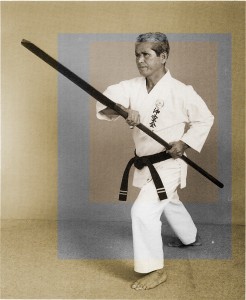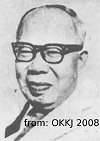A certain Chatan Yara Pēchin, who is said to have left behind Chatan Yara no Sai, is also said to have left behind the unique bōjutsu kata called Chatan Yara no Kon.
Techniques
With around ninety individual techniques (ok, this depends largely on how one counts) it is not the longest bōjutsu kata but is difficult and largely asymmetrical in its order of techniques. The enbusen follows a simple straight line, but with various 180° turns and two 360° turns, plus strikes to the left and right sides on four occasions. And it is basically unknown.
This kata deploys a variety of unique techniques not found in many other kata, such as left and right Gyaku-mochi Jōdan-ura-uke from Chūdan-suihei-kamae, a combo of three Chūdan-gyaku-uchi, or the Ō-gedan soto- and uchi-barai and many others. It also contains the unique sideways-strike-downfloat, in which the bō is slammed on the ground horizontally.
The kata not only deploys the regular and the reverse grip extensively, but also each the six-feet-, five-feet-, and four-feet-grip.

Yonamine Kōsuke with a move from the first lane of Chikin Sunakachi no Uēku-dī. Yonamine was a member og the Ryūkyū Kobudō Hozon Shinkōkai for many years, and at times was even vice-president.
It is quite intruiging that it finishes with a combination known from Tsuken Sunakake no Uēku, with which it also has other very specific techniques in common. In addition, Chatan Yara no Kon can be performed with an Uēku without any adaption to the gripping- and hand changing methods. I wonder whether there was a unilateral or a mutual influence between the two.
All of the above makes this kata one of the most advanced training tools.
Tradition
One final thing that adds to making this kata absolutely unique is that it is said to have been handed down by Kamiya Jinsei (1894-1964), a person a bit underestimated in kobudō circles.
Kamiya is described as a versatile and multitalented person, an ace in the worlds of medical care, education, entertainment, and martial arts. Born in Kuniyoshi in the old Takamine district (todays Itoman City), he studied under Gōjū-ryū Karate-dō founder Miyagi Chōjun and achieved renshi title.
From age 18 to 27 he studied at the current Jikei University School of Medicine, and following his certification returned home to Okinawa. Besides his business (pediatrics, obstetrics and gynecology) he left behind many achievements in the fields of public entertainment, education, and physical education. In addition, being qualified as a shihan of the Nomura-ryū, he made an effort for the preservation and promotion of Ryūkyū classical music and dance, by which he laid the foundation of performing arts in the current Itoman region.

Kamiya Jinsei, from OKKJ 2008.
After the end of WW II, he established the Shūrenkai Dōjō aiming at the resurrection of the martial arts. Miyagi Chōjun and many other martial artists performed at the grand opening ceremony. He was also instrumental in teaching bōjutsu and karate in the elementary and junior high schools and youth associations of the devastated post-war Itoman region, and for many years also served as the president of the Itoman District Athletic Association. Because of his important achievements he was featured in the encyclopedic Okinawa Daihyakka Jiten.
Besides Chatan Yara no Kon he also taught another high-level bō kata, namely Chōun no Kon, and besides he was probably also involved in the transmission of the epic Soeishi no Kon. These are all bōjutsu of the highest technical level to be found on Okinawa. In addition, I have the feeling he was involved in handing down Sesoko no Kon, but this is just a hypothesis of mine.
Versions
It should be noted that there is also a kata going by the same name Chatan Yara no Kon. You find this version all over the internet, but it is Chatan Yara in name only. However, to complicate the matter even more, the original Okinawan kata on which this Chatan Yara no Kon was based (i.e. Tokumine no Kon of Isshin-ryū) itself might have to be considered Tokumine in name only, and actually the original Chatan Yara no Kon might have provided a few inspirations. Anyway, by all standards and although we find a very specific signature technique of the real one in it, this has to be considered a completely different kata.
Prominency
The real Chatan Yara is rather rare and I wonder how many handful of people each in Okinawa and abroad ever learned it. There are no videos of it online (although it has once been performed by Minowa Katsuhiko and taped during a commemorative demonstration for the late Akamine Eisuke). It seems that in the Okinawan lineages where it is still extant it is considered something like a “style’s inner secrets”. Surely it is one of he last bōjutsu kata taught to students.
If you find a video of a kata titled Chatan Yara no Kon that does not include the following techniques, it is Chatan Yara in name only:
© 2015 – 2021, Andreas Quast. All rights reserved.
